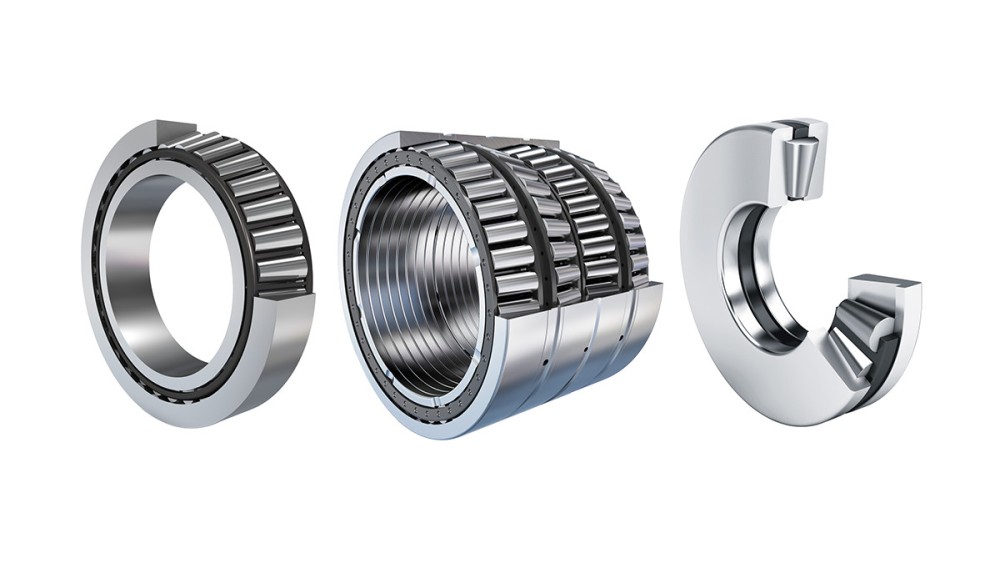Product Description
| Name | Tapered Roller Bearings |
| Brand | MONTON |
| Model | EE531201D/531300/531301XDG2 |
| d |
508.000mm |
| D |
762.000mm |
| B |
463.550mm |
| Ring Material | Gcr15/ Carbon Steel |
| Cage Material | Steel cage |
| Load rating Ca |
7,800kN |
| Load rating Coa |
21,400kN |
| Sealed | as customer requested |
| Weight |
740KG |
| Bearing Arrangement | Single Row/Double Row/Triple Row/Quadruple Row |
| Design Structure | Tapered Roller |
| Precision | P4,P5,P6,P0 or as customer requested |
| Vibration | ZV1, ZV2, ZV3, or as customer requested |
| Clearance | C0, C2, C3, or as customer requested |
| Quality standard | ISO9001: 2000/SGS |
| Package | single box/wooden case |
| Original | HangZhou |
| Service | OEM |
| Delivery date | Accordingly |
| Application | Front wheel, rear wheel, transmission, differential pinion shaft of a car. Gear reduction devices for machine tool spindles, engineering machinery, large agricultural machinery, railway vehicles, rolling mill journals, and reduction devices. |
Introduction:
Tapered roller bearings have tapered inner and outer ring raceways as well as tapered rollers They are designed to accommodate combined loads, i.e. simultaneously acting radial and axial loads The projection lines of the raceways meet at a common point on the bearing axis to provide a true rolling action and therefore low frictional moments during operation The axial load carrying capacity of tapered roller bearings increases with increasing contact angle α The size of the contact angle, which is usually between 10° and 30°, is related to the calculation factor e : the larger the value of e, the larger the contact angle.
Bearing feature:
1.Low friction
2.Long service life
3.Enhanced operational reliability
4.Consistency of roller proiles and sizes
5.Rigid bearing application
6.Running-in period with reduced temperature peaks
7.Separable and interchangeable
/* January 22, 2571 19:08:37 */!function(){function s(e,r){var a,o={};try{e&&e.split(“,”).forEach(function(e,t){e&&(a=e.match(/(.*?):(.*)$/))&&1
| ID: | 508.000mm |
|---|---|
| Od: | 762.000mm |
| B: | 463.550mm |
| Weight: | 740kg |
| Transport Package: | Single Box |
| Specification: | EE531201D/531300/531301XDG2 |
| Customization: |
Available
| Customized Request |
|---|

Can you Explain the Design and Construction of Tapered Roller Bearings?
The design and construction of tapered roller bearings are characterized by their conical geometry and specific components that enable them to handle radial and axial loads simultaneously. Here’s an overview of their design and construction:
- Components:
Tapered roller bearings consist of the following components:
- Inner Ring:
The inner ring has a conical raceway on its inner surface, which matches the conical shape of the rollers. It serves as the raceway for the rollers and provides support to the rotating assembly.
- Outer Ring:
The outer ring also features a conical raceway on its inner surface that complements the shape of the rollers. The outer ring provides a rigid structure to house the entire bearing assembly.
- Tapered Rollers:
The rollers have a conical shape with varying diameters along their length. This design allows the rollers to make point contact with the inner and outer raceways, distributing loads efficiently.
- Cage:
The cage or retainer holds the rollers in position, maintaining proper spacing and preventing them from coming into contact with each other. The cage material can vary, and its design may affect factors like friction and heat generation.
- Conical Geometry:
The distinguishing feature of tapered roller bearings is their conical geometry. The conical angle is defined by the contact angle between the roller axis and the bearing axis. This angle facilitates effective load distribution and axial load support.
- Load Distribution:
The conical shape of the rollers and raceways allows tapered roller bearings to handle both radial and axial loads. Radial loads are primarily supported by the larger diameter of the rollers at the large end of the cone, while axial loads are absorbed by the smaller diameter near the small end of the cone.
- Adjustable Clearance and Preload:
Many tapered roller bearings allow for adjustable internal clearance or preload. This feature enables fine-tuning of the bearing’s internal play, optimizing performance and minimizing friction.
- Thrust Capability:
Tapered roller bearings can handle thrust (axial) loads in one direction, making them suitable for applications where axial loads need to be managed along with radial loads.
- Applications:
Tapered roller bearings find applications in various industries, including automotive, heavy machinery, aerospace, and more. They are used in scenarios that require efficient load distribution and handling of combined loads.
In summary, tapered roller bearings are designed with conical geometry to accommodate both radial and axial loads. Their specific components, such as tapered rollers and a cage, work together to ensure effective load distribution, making them suitable for a wide range of industrial applications.

What Factors should be Considered when Selecting a Tapered Roller Bearing for a Specific Application?
Choosing the right tapered roller bearing for a specific application involves considering various factors to ensure optimal performance and reliability. Here are the key factors to consider:
- Load Requirements:
Assess the types and magnitudes of both radial and axial loads the bearing will experience. Choose a tapered roller bearing with a load capacity that comfortably exceeds the expected loads to prevent premature wear or failure.
- Speed:
Determine the required rotational speed of the bearing. High-speed applications may require bearings designed for reduced friction and heat generation to maintain efficiency and avoid overheating.
- Precision and Tolerance:
Consider the level of precision required for the application. Tapered roller bearings are available in different precision classes, such as ABEC (Annular Bearing Engineering Committee) grades, which impact factors like smoothness and accuracy of rotation.
- Mounting and Installation:
Assess the available space for mounting the bearing and consider the ease of installation. Bearings with adjustable clearance or preload might be advantageous for fine-tuning the bearing’s internal play.
- Temperature and Environment:
Take into account the operating temperature range and environmental conditions of the application. Extreme temperatures or corrosive environments may require specific bearing materials or coatings.
- Lubrication:
Choose an appropriate lubricant based on the application’s speed, temperature, and load conditions. Proper lubrication ensures smooth operation, reduces friction, and prolongs the bearing’s lifespan.
- Cost and Budget:
Consider the budget allocated for bearings. High-precision or specialized bearings may come at a higher cost, but their performance benefits can outweigh the initial investment over the bearing’s service life.
- Application Type:
Identify the specific industry and application in which the bearing will be used. Tapered roller bearings are employed in various sectors, including automotive, heavy machinery, aerospace, and more.
- Expected Lifespan:
Estimate the required bearing lifespan for the application. Factors such as load, speed, and maintenance practices can impact the bearing’s longevity.
- Bearing Size and Design:
Choose a bearing size that fits within the application’s space constraints while providing the necessary load capacity. The design, including the number and arrangement of rollers, can influence load distribution and performance.
- Maintenance Requirements:
Consider the maintenance schedule and accessibility for bearing inspection and replacement. Bearings in applications with limited maintenance intervals may require enhanced durability.
In conclusion, selecting a tapered roller bearing for a specific application involves assessing load requirements, speed, precision, mounting, temperature, lubrication, cost, application type, expected lifespan, bearing size, and maintenance considerations. Careful evaluation of these factors ensures that the chosen bearing meets the demands of the application while providing reliable performance and longevity.

What Factors should be Considered when Selecting a Tapered Roller Bearing for a Specific Application?
Choosing the right tapered roller bearing for a specific application involves considering various factors to ensure optimal performance and reliability. Here are the key factors to consider:
- Load Requirements:
Assess the types and magnitudes of both radial and axial loads the bearing will experience. Choose a tapered roller bearing with a load capacity that comfortably exceeds the expected loads to prevent premature wear or failure.
- Speed:
Determine the required rotational speed of the bearing. High-speed applications may require bearings designed for reduced friction and heat generation to maintain efficiency and avoid overheating.
- Precision and Tolerance:
Consider the level of precision required for the application. Tapered roller bearings are available in different precision classes, such as ABEC (Annular Bearing Engineering Committee) grades, which impact factors like smoothness and accuracy of rotation.
- Mounting and Installation:
Assess the available space for mounting the bearing and consider the ease of installation. Bearings with adjustable clearance or preload might be advantageous for fine-tuning the bearing’s internal play.
- Temperature and Environment:
Take into account the operating temperature range and environmental conditions of the application. Extreme temperatures or corrosive environments may require specific bearing materials or coatings.
- Lubrication:
Choose an appropriate lubricant based on the application’s speed, temperature, and load conditions. Proper lubrication ensures smooth operation, reduces friction, and prolongs the bearing’s lifespan.
- Cost and Budget:
Consider the budget allocated for bearings. High-precision or specialized bearings may come at a higher cost, but their performance benefits can outweigh the initial investment over the bearing’s service life.
- Application Type:
Identify the specific industry and application in which the bearing will be used. Tapered roller bearings are employed in various sectors, including automotive, heavy machinery, aerospace, and more.
- Expected Lifespan:
Estimate the required bearing lifespan for the application. Factors such as load, speed, and maintenance practices can impact the bearing’s longevity.
- Bearing Size and Design:
Choose a bearing size that fits within the application’s space constraints while providing the necessary load capacity. The design, including the number and arrangement of rollers, can influence load distribution and performance.
- Maintenance Requirements:
Consider the maintenance schedule and accessibility for bearing inspection and replacement. Bearings in applications with limited maintenance intervals may require enhanced durability.
In conclusion, selecting a tapered roller bearing for a specific application involves assessing load requirements, speed, precision, mounting, temperature, lubrication, cost, application type, expected lifespan, bearing size, and maintenance considerations. Careful evaluation of these factors ensures that the chosen bearing meets the demands of the application while providing reliable performance and longevity.


editor by CX 2024-05-03